A Day at the Great Wild Goose Pagoda: Experience Xi’an’s Buddhist Heritage
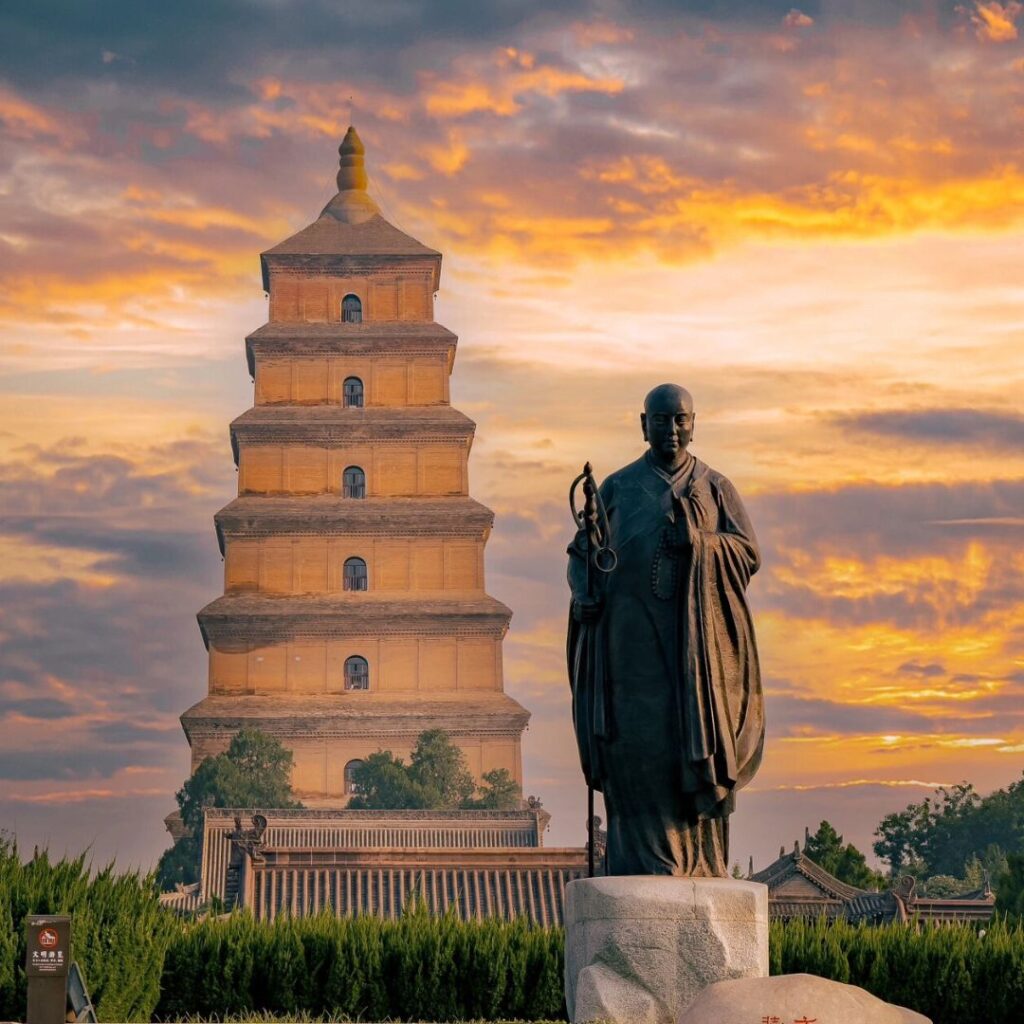
An Essential Guide to Visiting Great Wild Goose Pagoda
In This Guide
- An Essential Guide to Visiting Great Wild Goose Pagoda
- The Rich History and Legends of Great Wild Goose Pagoda
- Main Highlights: What You Absolutely Can’t Miss
- Planning Your Visit: A Practical Guide
- Tickets: Prices, Booking, and Tips
- How to Get There: A Complete Transportation Guide
- Local Cuisine and Accommodation Nearby
- Frequently Asked Questions
- Final Thoughts on Your Trip
Visiting the Great Wild Goose Pagoda is like stepping back in time to the flourishing Tang Dynasty, a period renowned for its cultural and artistic achievements. This monumental Buddhist pagoda, affectionately known as the Big Wild Goose Pagoda, stands as a testament to the era’s architectural ingenuity and spiritual devotion. Erected in 652 AD, it was built to house sacred Buddhist texts and relics brought back from India by the revered monk Xuanzang, whose legendary journey inspired countless stories and films.
As you approach this magnificent seven-story structure, towering at 210 feet, you’ll immediately be captivated by its elegant pavilion-style design, which uniquely embodies the spirit of Tang artistry. Each level of the pagoda offers a glimpse into the rich history of Buddhism in China, showcasing intricate carvings and ancient relics that narrate the profound connection between religion and art during this golden age.
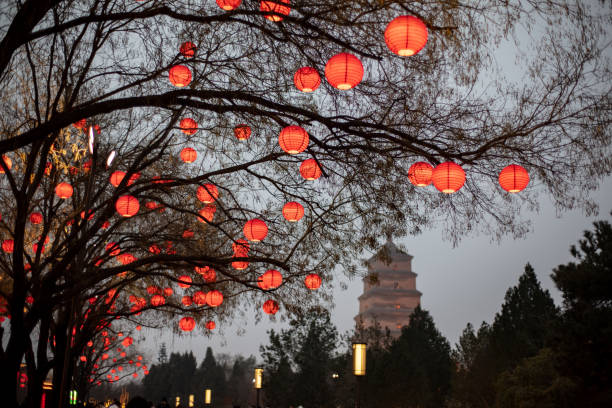
Great_Wild_Goose_Pagoda.
But the Great Wild Goose Pagoda is not merely a historical landmark; it is the centerpiece of a vibrant temple complex, Da Ci’en Temple, where the past intertwines with the present. Here, visitors can explore tranquil courtyards, meditate near serene Buddha statues, and even enjoy a spectacular musical fountain show that brings the area to life in a dazzling display of water and light.
Whether you’re a history enthusiast, a cultural explorer, or a casual traveler, the Great Wild Goose Pagoda promises an enriching experience that will leave you with lasting memories of Xi’an’s rich heritage. Prepare to be inspired as you uncover the incredible narrative woven into the fabric of this iconic monument.
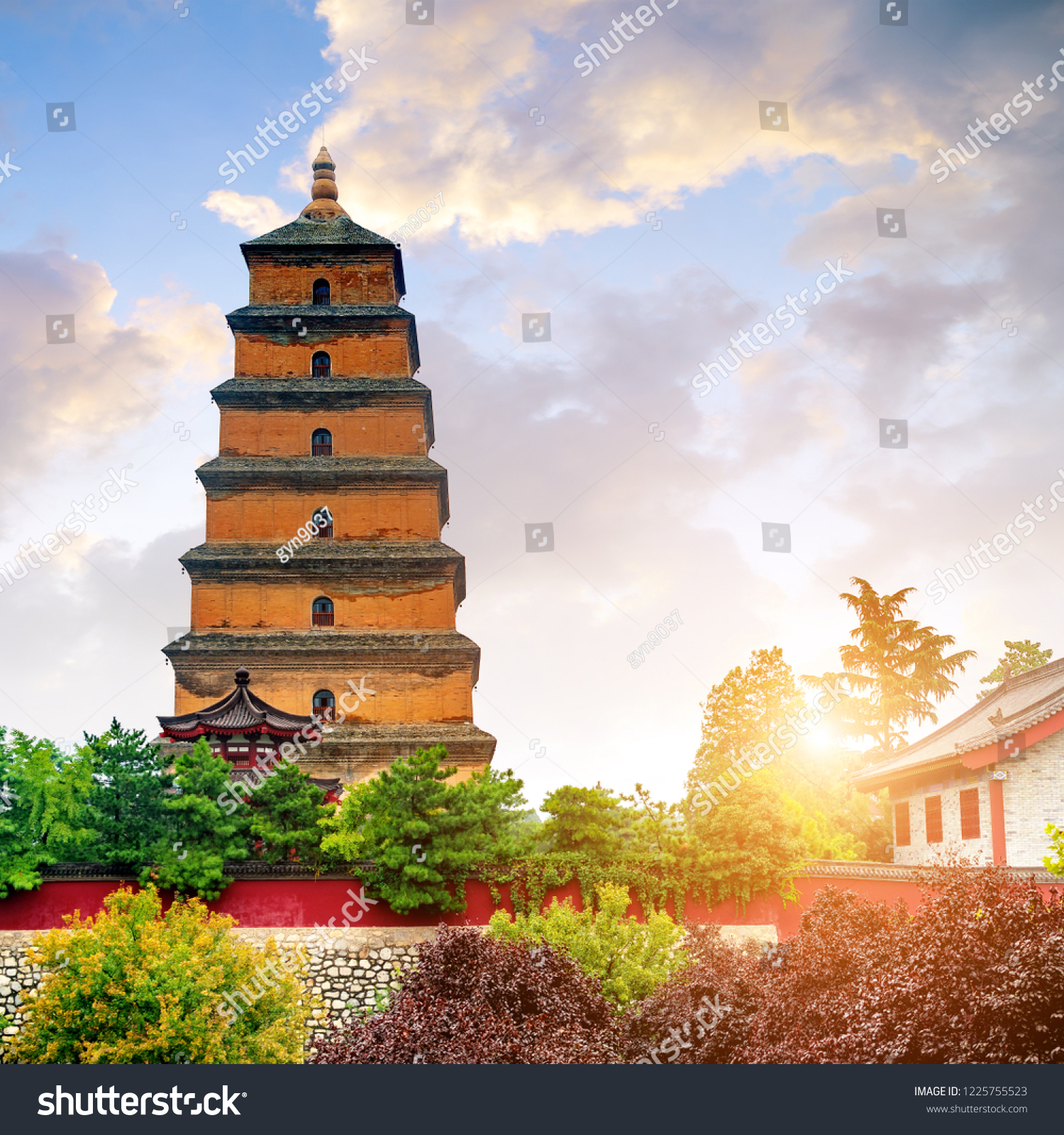
Great_Wild_Goose_Pagoda.
The Rich History and Legends of Great Wild Goose Pagoda
The Great Wild Goose Pagoda, or Dayan Pagoda, is not merely an architectural marvel but a profound emblem of Xi’an’s rich tapestry of history, spirituality, and cultural exchange. Erected in 652 AD during the Tang Dynasty, this venerable structure was conceived by the eminent monk Xuanzang, who famously undertook an arduous journey to India to acquire Buddhist scriptures and relics. The pagoda was built to house these invaluable treasures, symbolizing a bridge between cultures and the quest for knowledge that defined the Tang era.
Architectural Significance
Standing at 64.5 meters tall, the Great Wild Goose Pagoda is the largest and best-preserved example of Tang Dynasty pavilion-style architecture. Its seven stories are elegantly designed with a harmonious blend of function and aesthetics, making it a striking presence against the backdrop of Xi’an’s skyline. The pagoda has undergone several restorations, notably during the reign of Empress Wu Zetian in 704 AD and further renovations in the Ming Dynasty. Each layer of brick has a story to tell, reflecting the artistic and engineering prowess of the time.

Great_Wild_Goose_Pagoda.
Xuanzang: The Legend Behind the Pagoda
The pagoda is deeply intertwined with the legendary figure of Xuanzang, whose pilgrimage to India is a tale of determination and faith. Xuanzang, also known as Sanzang, faced numerous challenges during his journey, including treacherous landscapes and hostile encounters. His unwavering commitment to Buddhism and the pursuit of enlightenment culminated in the successful retrieval of sacred texts. Upon his return, he not only established the pagoda but also translated many scriptures, significantly influencing Buddhist thought in China. Xuanzang’s legacy is immortalized through statues and memorials within the temple complex, allowing visitors to connect with his extraordinary journey.
Cultural Symbolism
Throughout the centuries, the Great Wild Goose Pagoda has emerged as a cultural touchstone, representing the Tang Dynasty’s support for Buddhism and its integration into the fabric of Chinese society. The pagoda stands as a testament to the era’s artistic achievements and the profound spiritual beliefs that guided the populace. It is often depicted in literature and art, symbolizing peace, enlightenment, and the flourishing of cultural exchange along the ancient Silk Road.

Great_Wild_Goose_Pagoda.
Legends and Folklore
Over time, the pagoda has also inspired numerous legends and folklore. One such tale speaks of a hidden treasure buried beneath its foundations, said to be the remains of sacred relics brought back by Xuanzang. Locals believe that on certain nights, the spirit of the monk can be seen ascending the pagoda, ensuring the protection of the city and its inhabitants. Such stories enrich the cultural heritage surrounding the pagoda, inviting visitors to engage with its historical depths and spiritual significance.
A Living Legacy
Today, the Great Wild Goose Pagoda is not only a relic of the past but a vibrant part of Xi’an’s present. It attracts thousands of visitors each year who come to marvel at its grandeur and explore the surrounding Da Ci’en Temple complex. The area is alive with activity, featuring stunning gardens, ancient relics, and the mesmerizing musical fountain show that captivates audiences nightly.

Great_Wild_Goose_Pagoda.
In summary, the Great Wild Goose Pagoda is much more than an architectural feat; it is a living testament to the intertwining of history, culture, and spirituality. As you stand before its towering structure, take a moment to reflect on the incredible journey of Xuanzang and the myriad stories that have unfolded around this iconic symbol of Xi’an.
Main Highlights: What You Absolutely Can’t Miss
Discovering the Giant Wild Goose Pagoda: Key Highlights You Can’t Miss
When visiting Xi’an, the Giant Wild Goose Pagoda (大雁塔), an architectural marvel of the Tang Dynasty, is an unmissable experience that beautifully encapsulates China’s rich history and Buddhist heritage. Here’s a guide to the essential highlights of this iconic site:

Great_Wild_Goose_Pagoda.
1. The Majestic Structure
Standing at an impressive 64.5 meters (210 feet) tall, the Giant Wild Goose Pagoda boasts seven stories of captivating architecture. Its pavilion-style design not only showcases the artistic brilliance of the Tang Dynasty but also serves as a historical relic that houses invaluable Buddhist scriptures and relics.
- Tip: Climbing the pagoda is highly recommended. With 256 steps leading to the top, you’ll be rewarded with breathtaking views of the surrounding Da Ci’en Temple complex and beyond.
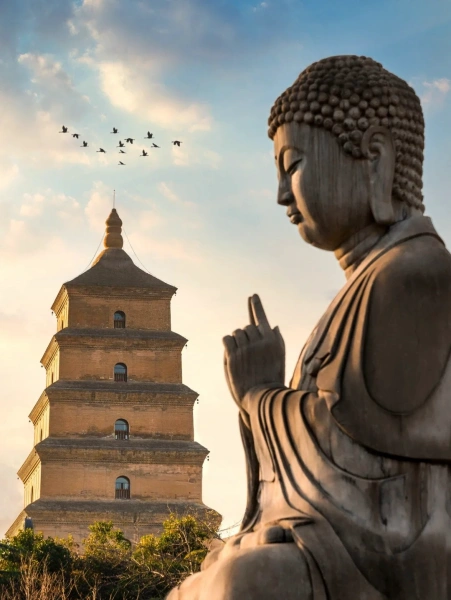
Great_Wild_Goose_Pagoda.
2. Inside the Pagoda
Step inside this ancient structure to explore its carefully curated exhibits:
- First Floor: Historic carved tablets presenting the pagoda’s rich history.
- Second Floor: Features a statue of Sakyamuni Buddha.
- Third and Fourth Floors: Home to ancient texts and relics that shed light on Buddhist culture.
- Fifth Floor: Admire the exquisite lotus-patterned architecture, a testament to Tang artistry.
- Sixth and Seventh Floors: Enjoy panoramic vistas of the Da Ci’en Temple and the vibrant Tang Paradise.
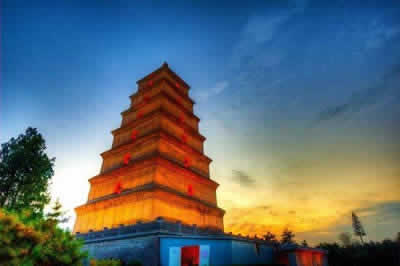
Great_Wild_Goose_Pagoda.
3. Da Ci’en Temple
While the pagoda steals the show, the Da Ci’en Temple complex is a treasure trove of history. Spanning 12.5 acres, this serene environment features:
- Buddha Statues: Numerous statues scattered across peaceful courtyards.
- Hall of Xuanzang: Dedicated to the great monk who brought Buddhist texts from India, offering insights into his spiritual journey.
- Hall of Mahavira: A stunning space that reflects the temple’s profound history.
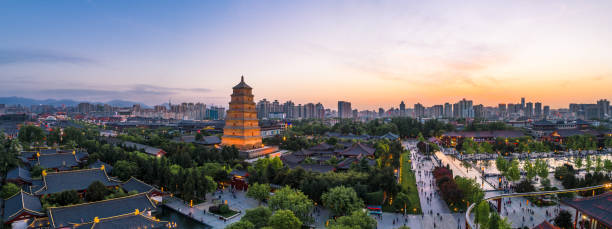
Great_Wild_Goose_Pagoda.
4. The Musical Fountain Show
As night falls, head to the North Square for a mesmerizing Musical Fountain Show. This free spectacle features water dancing to captivating music, illuminating the night with vibrant colors—an experience that captivates both young and old alike.
- Show Times: Daily performances at 12 p.m., 4 p.m., 7 p.m., and 9 p.m. (Note: Daytime shows are canceled every Tuesday for maintenance).
5. Tang Ci’en Temple Site Park
Adjacent to the pagoda, the Tang Ci’en Temple Site Park offers a tranquil escape. Here, you can:
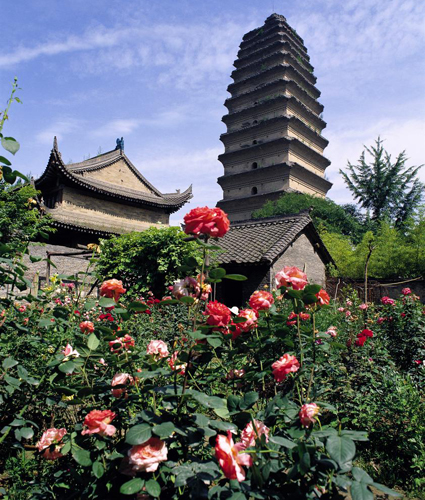
Great_Wild_Goose_Pagoda.
- Practice Tai Chi: Join locals in this traditional exercise amidst beautiful gardens.
- Explore Historical Relics: Discover remnants of the temple’s past and enjoy peaceful strolls through the greenery.
6. Tang Paradise
For a truly immersive experience, visit Tang Paradise, a sprawling 165-acre park that recreates the grandeur of the Tang Dynasty. Here, you can:
- Enjoy Live Performances: Witness traditional music and dance.
- Try Calligraphy: Engage with this art form and create your own masterpiece.
- Dress in Hanfu: Capture stunning photos in traditional attire against the backdrop of beautifully lit Tang architecture.

Great_Wild_Goose_Pagoda.
7. Practical Travel Tips
- Opening Hours: The Da Ci’en Temple is open from 8:30 a.m. to 5 p.m., while the pagoda opens at 9 a.m.
- Ticket Prices: Entry to Da Ci’en Temple is 30 RMB (approx. $4 USD), with an additional 25 RMB to climb the pagoda.
- Best Time to Visit: Spring and autumn are ideal for experiencing the gardens in full bloom and enjoying comfortable weather.
- Getting There: Accessible via Metro Line 3 to Dayanta Station, or by taxi from the city center.
8. A Note on the Smaller Cousin
Don’t confuse the Giant Wild Goose Pagoda with the Small Wild Goose Pagoda. While both are relics of the Tang Dynasty, the Giant Wild Goose Pagoda is the more significant and recommended site for visitors with limited time.
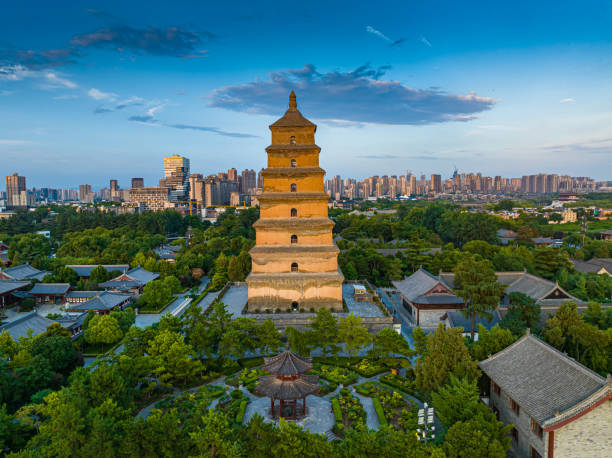
Great_Wild_Goose_Pagoda.
Wrap-Up
The Giant Wild Goose Pagoda is not just a monument; it’s a gateway into the spiritual and cultural heart of ancient China. From its towering structure and rich interiors to the surrounding temple complex and lively performances, every moment spent here is steeped in history and beauty. Don’t miss the chance to experience this UNESCO World Heritage site—it will undoubtedly be a highlight of your journey through Xi’an.
Planning Your Visit: A Practical Guide
Essential Information for Your Visit to the Giant Wild Goose Pagoda
The Giant Wild Goose Pagoda, known locally as Dayan Pagoda, is a remarkable testament to China’s rich Buddhist history and architectural ingenuity. A visit to this iconic structure in Xi’an is not merely a sightseeing stop; it is an immersion into the cultural and spiritual heritage of the Tang Dynasty. Here’s all you need to know to make the most of your visit.
Getting There
Location: The Giant Wild Goose Pagoda is located at No. 1 Ci’en Road, Yanta District, Xi’an, approximately a 20-minute drive from the city center.
Transportation Options:
– Metro: Take Metro Line 3 to Dayanta Station and follow the signs to the pagoda.
– Taxi/Rideshare: Easily available throughout Xi’an; ensure the driver understands your destination.
Opening Hours and Ticket Prices
- Da Ci’en Temple Complex: 8:30 AM – 5:00 PM
- Giant Wild Goose Pagoda: Opens at 9:00 AM
- Ticket Prices:
- Entry to Da Ci’en Temple: 30 RMB (approximately $4 USD)
- Climbing the Giant Wild Goose Pagoda: 25 RMB
No reservations are required, but it’s advisable to arrive early to avoid crowds.
Best Times to Visit
Optimal Seasons:
– Spring: Enjoy blooming gardens and pleasant weather.
– Autumn: Marvel at the vibrant colors of persimmon trees.
Timing Your Visit: To experience fewer crowds, plan your visit early in the morning or later in the afternoon. Complement your visit with the evening musical fountain show, which is a spectacular highlight of the area.
What to Expect Inside the Pagoda
The Giant Wild Goose Pagoda stands at an impressive 64.5 meters (approximately 210 feet) with seven stories. Visitors can climb the 256 steps to explore various floors, each housing significant relics and historical artifacts.
- First Floor: Historic carved tablets
- Second Floor: A statue of Sakyamuni Buddha
- Third and Fourth Floors: Ancient texts and relics
- Fifth Floor: Tang Dynasty architectural art
- Sixth and Seventh Floors: Panoramic views of the surrounding Da Ci’en Temple complex
Exploring the Surrounding Area
The Giant Wild Goose Pagoda is situated within the sprawling Da Ci’en Temple complex, which is rich in cultural sites and activities:
-
Da Ci’en Temple: Wander through serene courtyards and admire numerous Buddha statues. Don’t miss the Hall of Xuanzang, dedicated to the monk who brought Buddhist scriptures from India.
-
Tang Ci’en Temple Site Park: A tranquil space perfect for a leisurely stroll or Tai Chi practice, featuring beautiful gardens and historical relics.
-
Musical Fountain Show: Held at the North Square, this free show features dancing water synchronized to music, with performances at 12 PM, 4 PM, 7 PM, and 9 PM (note: midday shows are canceled on Tuesdays for maintenance).
-
Tang Paradise: A vibrant cultural park themed around the Tang Dynasty, offering live performances, traditional crafts, and delicious local cuisine. An enchanting experience, especially when illuminated at night.
Practical Tips for Your Visit
- Wear Comfortable Shoes: Climbing the pagoda and exploring the temple grounds requires good footwear.
- Stay Hydrated: Bring water, especially in warmer months, as you’ll be walking outdoors.
- Photography: Capture stunning views from the top of the pagoda and the beautiful landscapes around the temple complex.
A Note on the Small Wild Goose Pagoda
Be aware that Xi’an is home to two pagodas with similar names. The Small Wild Goose Pagoda is located in Jianfu Temple and features a different architectural style. If time permits, both offer unique insights into the Tang Dynasty but prioritize the Giant Wild Goose Pagoda for its climbable structure and extensive relics.
Conclusion
Visiting the Giant Wild Goose Pagoda is not just about admiring an architectural marvel; it’s about connecting with a pivotal part of Chinese history and spirituality. With careful planning and an appreciation for the cultural significance of the site, your visit will be both enjoyable and enlightening. Prepare for an experience that intertwines history, art, and the serene beauty of one of China’s most revered landmarks.
Tickets: Prices, Booking, and Tips
When planning your visit to the magnificent Giant Wild Goose Pagoda, understanding ticket prices, booking options, and essential tips can enhance your experience. Here’s everything you need to know to make your visit seamless and enjoyable.
Ticket Prices
- Da Ci’en Temple Entrance Fee: 30 RMB (approximately $4 USD)
- Climbing the Giant Wild Goose Pagoda: An additional 25 RMB (about $3.50 USD)
Booking Information
- Reservation: No prior reservation is required for purchasing tickets. You can buy them at the entrance when you arrive.
- Payment Options: Cash is usually accepted, but it’s advisable to have a mobile payment app like WeChat Pay or Alipay, as these are commonly used in China.
Opening Hours
- Da Ci’en Temple Complex:
- Opens at 8:30 AM
- Closes at 5:00 PM
- Giant Wild Goose Pagoda:
- Opens at 9:00 AM
- Last entry is typically around 4:30 PM
Recommended Visiting Times
- Duration: Plan to spend about 1 to 1.5 hours exploring the pagoda and the surrounding temple complex.
- Best Times to Visit: Early morning or late afternoon is ideal to avoid crowds and enjoy a more tranquil atmosphere. Spring and autumn are particularly beautiful seasons to visit, showcasing vibrant flowers and stunning foliage.
Additional Tips
- Dress Comfortably: Wear comfortable shoes as there are 256 steps to climb if you choose to go up the pagoda, and you will be doing quite a bit of walking throughout the temple complex.
- Stay Hydrated: Bring water with you, especially during warmer months, as much of the site is outdoors.
- Combine Your Visit: If time permits, consider staying for the Musical Fountain Show in the North Square, which features captivating water displays set to music. The show runs at various times in the evening, making for a perfect conclusion to your day.
- Transportation: The pagoda is easily accessible via public transport, with Metro Line 3 taking you directly to Dayanta Station, just a short walk from the entrance.
Know Before You Go
- Other Attractions: If you have time, explore the nearby Tang Paradise, a cultural park that beautifully recreates the essence of the Tang Dynasty, complete with themed performances and traditional crafts.
- Distinguishing Pagodas: Remember that Xi’an has two pagodas with similar names. The Small Wild Goose Pagoda, located in Jianfu Temple, is another historical site you may wish to explore, but the Giant Wild Goose Pagoda is generally recommended as the more impressive of the two.
By keeping this information in mind, you will be well-equipped to enjoy your visit to the Giant Wild Goose Pagoda, immersing yourself in the rich history and culture that this remarkable site embodies.
How to Get There: A Complete Transportation Guide
Getting to the Giant Wild Goose Pagoda: Your Comprehensive Transportation Guide
Visiting the Giant Wild Goose Pagoda (大雁塔) in Xi’an is an essential cultural experience that transports you back to the grandeur of the Tang Dynasty. Whether you’re coming from the city center or the surrounding regions, getting to this iconic site is straightforward and accessible. Below are your options for reaching this monumental pagoda.
1. By Metro
The most convenient way to reach the Giant Wild Goose Pagoda is via the Xi’an Metro.
- Line: Take Metro Line 3.
- Station: Get off at Dayanta Station (大雁塔站).
- Exit: Follow the signs to Exit A, which will lead you directly to the pagoda and the surrounding Da Ci’en Temple complex. The walk from the metro station to the pagoda takes about 10 minutes.
2. By Bus
If you prefer to experience the local transport, Xi’an’s bus network offers several routes that can take you close to the pagoda.
- Routes: Look for buses 30, 34, 45, 215, or 601.
- Stop: Alight at the Da Ci’en Temple or Wild Goose Pagoda stop, both of which are just a short walk from the entrance.
3. By Taxi or Ride-Hailing Services
For a more direct and comfortable journey, consider taking a taxi or using a ride-hailing app like Didi.
- From City Center: A taxi ride from the city center to the pagoda usually takes about 20-30 minutes, depending on traffic.
- Cost: Expect to pay around 30-50 RMB (approximately $5-$8) for the fare.
4. By Bicycle or E-Scooter
For the more adventurous traveler, renting a bicycle or an electric scooter can be a delightful way to explore Xi’an.
- Rentals: Look for bike-sharing programs available throughout the city.
- Distance: The ride from the city center to the pagoda is approximately 5 km (3 miles) and should take about 20-30 minutes.
5. Guided Tours and Shuttle Services
If you prefer a hassle-free experience, consider booking a guided tour that includes transportation.
- Tour Operators: Many local tour companies offer packages that include transportation to and from the pagoda, along with guided services to enhance your understanding of this historic site.
- Advantages: This option often includes skip-the-line tickets, allowing you to explore without the waiting time.
Important Tips for Travelers
- Opening Hours: The Giant Wild Goose Pagoda is open daily from 9:00 AM to 5:00 PM, while the Da Ci’en Temple opens at 8:30 AM. Arriving early can help you avoid crowds.
- Ticket Prices: Entrance to the Da Ci’en Temple costs 30 RMB, and an additional 25 RMB if you wish to climb the pagoda.
- Wear Comfortable Shoes: If you plan to explore the pagoda and the surrounding complex, ensure you wear sturdy footwear. The climb includes 256 steps!
Final Thoughts
No matter your mode of transport, visiting the Giant Wild Goose Pagoda is a journey that combines convenience with cultural immersion. As you approach this ancient structure, take a moment to appreciate its historical significance and the beauty that surrounds it. Enjoy your adventure in Xi’an!
Local Cuisine and Accommodation Nearby
When visiting the Great Wild Goose Pagoda, immersing yourself in the local flavors and comfortable accommodations can enhance your cultural experience in Xi’an. This vibrant city, steeped in history, offers a delightful array of culinary delights and lodging options that cater to international travelers.
Culinary Delights to Savor
Xi’an is renowned for its unique and diverse food scene, featuring flavors that reflect its rich history along the ancient Silk Road. Here are some must-try dishes and local eateries:
-
Biang Biang Noodles (油条面):
These hand-pulled, wide noodles are a signature dish of Xi’an. They are typically served with a spicy sauce, vegetables, and meat. For an authentic experience, visit 老碗面 (Old Bowl Noodles) located near the pagoda. -
Rou Jia Mo (肉夹馍):
Often referred to as a “Chinese hamburger,” this dish consists of a meat filling, commonly braised pork, tucked inside a flatbread. Yongxing Noodle House is famous for its Rou Jia Mo and is an excellent spot for a quick bite. -
Yangrou Paomo (羊肉泡馍):
A hearty mutton soup served with crumbled flatbread, this dish is perfect for experiencing local flavors. Tian Yi Restaurant is highly recommended for its rich broth and tender meat. -
Shaanxi-style Dumplings (水饺):
These dumplings are filled with various ingredients and are often served in broth or steamed. Dumpling Banquet at Defu Lane offers a wide variety and an immersive dining experience. -
Pomegranate Juice (石榴汁):
A refreshing drink that is popular in Xi’an, especially during warmer months. Look for street vendors around the pagoda to enjoy this natural treat.
Nearby Accommodations
For a comfortable stay close to the Great Wild Goose Pagoda, consider these accommodations, each providing a unique blend of comfort and convenience:
-
Sofitel Xi’an on Renmin Square:
This five-star hotel offers luxurious accommodations with a blend of French and Chinese aesthetics. Located just a short drive from the pagoda, it features modern amenities, a spa, and exquisite dining options. -
Grand Park Xian:
Situated within walking distance of the pagoda, this hotel offers comfortable rooms, a fitness center, and a lovely garden. It’s a great choice for travelers wanting easy access to local attractions. -
Hanting Hotel Xi’an Dayanta:
An economical option, this hotel provides clean and comfortable rooms at budget-friendly prices. It’s conveniently located near the Metro Line 3, making it easy to explore the city. -
Xi’an Old City Youth Hostel:
For those on a budget or seeking a social atmosphere, this hostel offers dormitory-style accommodations and private rooms. It’s known for its friendly staff and communal vibe, making it easy to meet fellow travelers. -
Hilton Xi’an:
A luxurious option, this hotel combines modern comforts with traditional Chinese decor. Located near several major attractions, including the pagoda, it boasts a variety of dining options and a relaxing spa.
Conclusion
A trip to the Great Wild Goose Pagoda is not just about exploring its historical significance, but also about indulging in the local cuisine and enjoying the hospitality of nearby accommodations. From savoring the rich flavors of Xi’an to resting in comfort after a day of exploration, you’ll find that the essence of this ancient city is beautifully captured in its food and lodging. Make sure to take the time to enjoy both during your visit!
Frequently Asked Questions
Frequently Asked Questions About the Great Wild Goose Pagoda
1. What is the history of the Great Wild Goose Pagoda?
The Great Wild Goose Pagoda, also known as the Giant Wild Goose Pagoda, was built in 652 during the Tang Dynasty to house Buddhist scriptures and relics brought back from India by the monk Xuanzang. It was later reconstructed in 704 under Empress Wu Zetian and restored during the Ming Dynasty. This architectural marvel stands as a symbol of the Tang Dynasty’s cultural and artistic achievements.
2. What are the opening hours and ticket prices?
The Da Ci’en Temple complex, which includes the Great Wild Goose Pagoda, is open from 8:30 AM to 5 PM. Admission to the temple costs 30 RMB (approximately $4 USD), and an additional 25 RMB is required to climb the pagoda.
3. How many floors does the pagoda have, and can visitors climb it?
The Great Wild Goose Pagoda features seven stories, reaching a height of approximately 210 feet (64.5 meters). Visitors can climb to the top, where they will enjoy panoramic views of the surrounding Da Ci’en Temple complex.
4. What should I expect to see inside the pagoda?
Inside the pagoda, visitors can explore a variety of historical relics and carvings. The first floor contains carved tablets, while subsequent floors house ancient texts, a statue of Sakyamuni Buddha, and Tang Dynasty art, culminating in stunning views from the top.
5. Is there a musical fountain show nearby?
Yes! The North Square features a free musical fountain show that takes place at night. The show is a dazzling spectacle of water, light, and music, with performances at 7 PM and 9 PM. Note that the daytime shows at 12 PM and 4 PM are canceled every Tuesday for maintenance.
6. How can I get to the Great Wild Goose Pagoda?
The pagoda is conveniently located in the Yanta District of Xi’an. You can reach it by taking Metro Line 3 to Dayanta Station, which is just a short walk away. Alternatively, taxis and ride-sharing services are widely available in the city.
7. What is the best time of year to visit?
Spring and autumn are ideal seasons to visit the Great Wild Goose Pagoda. Spring showcases blooming gardens, while autumn offers beautiful views of persimmon trees. These seasons provide comfortable weather for exploring the temple complex and surrounding areas.
8. Are there any other attractions nearby?
Absolutely! In addition to the Great Wild Goose Pagoda, visitors can explore the expansive Da Ci’en Temple, the peaceful Tang Ci’en Temple Site Park, and the immersive Tang Paradise, which offers themed cultural experiences, live performances, and traditional cuisine. Don’t miss the chance to stroll through these serene and culturally rich sites!
Final Thoughts on Your Trip
As you prepare to leave Xi’an, take a moment to reflect on the profound experience you’ve had at the Giant Wild Goose Pagoda. This architectural marvel is not just a stunning example of Tang Dynasty artistry; it is a gateway into a rich tapestry of history, spirituality, and culture that spans centuries.
A Journey Through Time
The Giant Wild Goose Pagoda stands tall as a testament to the devotion of Empress Wu Zetian and the legendary monk Xuanzang, who journeyed to India to bring back invaluable Buddhist texts. Walking through its seven stories, you’ve encountered the echoes of their passions, dreams, and the very essence of Tang culture. Each step up the pagoda has offered you a glimpse into the historical significance of Buddhism in shaping Chinese civilization.
Unforgettable Experiences
Your visit was undoubtedly filled with unforgettable moments:
- Breathtaking Views: From the top floors, you were rewarded with panoramic views of the Da Ci’en Temple complex and the vibrant Tang Paradise, capturing memories that will last a lifetime.
- Cultural Immersion: Whether it was wandering through serene gardens, enjoying the mesmerizing musical fountain show, or savoring the flavors of local cuisine, you were immersed in the essence of Xi’an.
- Historical Insights: Engaging with the relics and artifacts inside the pagoda has deepened your understanding of the region’s Buddhist heritage and its architectural innovations.
Final Thoughts
As you leave this magnificent site, remember that the Giant Wild Goose Pagoda is more than just a structure; it’s a symbol of resilience, enlightenment, and cultural confluence. It invites you to carry its stories and lessons with you as you journey onward. Whether you’re returning home or heading to your next adventure, let the spirit of Xi’an inspire you to explore further, learn deeper, and embrace the rich histories that shape our world.
Your time spent here is a reminder that travel is not just about the destinations we visit, but the stories we gather along the way. Safe travels, and may your future journeys be as enriching as the one you’ve just completed!